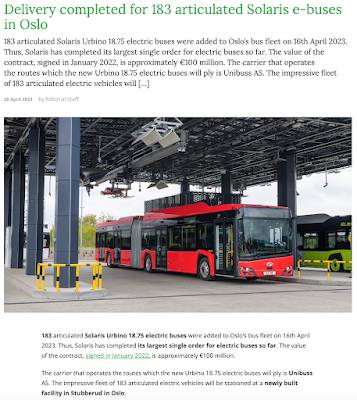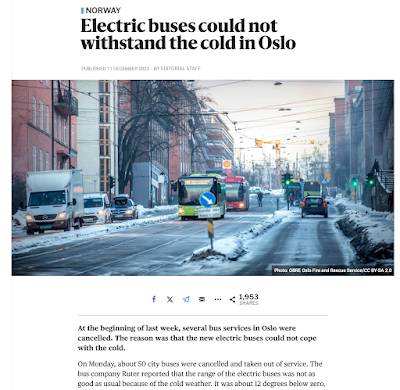
Lithium Battery Technology – The Snake Oil Solution to the Climate Emergency
Doesn’t this seem like a wonderful idea? Emissions-free mass transit, killing two “climate change birds” with one stone:
Here’s a quote:
“Thanks to such investments, “Oslo is getting closer to becoming the first city in the world to boast 100% emission-free public transport! Moreover, everything indicates that the goal of completely emission-free public transport set by the metropolis will be achieved 5 years earlier than expected”, the manufacturer says.“
But, let’s look at reality according to the Nordic Times:
..and, another quote with my bolds:
“…The buses run out of power more quickly. We are now registering what happens day by day, and then we will see how we can improve this in the future, Cathrine Myhren-Haugen, communications manager at Ruter, told the Norwegian newspaper Nordre Aker Budstikke.“
“On Tuesday, the cold weather continued to cause problems for the electric buses and more departures had to be cancelled. A total of 90 bus departures were reportedly canceled.“
For those of us who live in northern climes, we are already aware of the limitations of lithium battery technology in cold weather. While vehicles powered with lithium batteries may function well in climates like those found in southern Europe and southern parts of the United States (as long as temperatures aren’t too high which also negatively impacts lithium batteries), such is not the case where winter temperatures significantly degrade the range of EVs of all types.
Here is a quote from research by Shuai Ma et al in an article entitled “Temperature effect and thermal impact in lithium-ion batteries: A review“:
“The performance of LIB (lithium ion batteries) will degrade at temperatures below 0 °C . In 2001, Nagasubramanian showed that the power and energy densities of Panasonic 18650 LIBs were ~800 W/L and ~100 Wh/L at 25 °C, and these values were reduced by 98.75% and 95% to < 10 W/L and ~5 Wh/L at −40 °C. In another report, the state of charge (SOC) of a LIB, which is defined as the ratio of the present residual capacity to the overall available capacity, was also found to decrease by ~23% when the operating temperature decreased from 25 °C to −15 °C.
…and, even more worrying is this:
“Most of the temperature effects are related to chemical reactions occurring in the batteries and also materials used in the batteries. Regarding chemical reactions, the relationship between the rate of chemical reactions and reaction temperature follows Arrhenius equation, and temperature variation can lead to the change of electrochemical reaction rate in batteries. Besides chemical reactions, the ionic conductivities of electrodes and electrolytes are also affected by temperature. For example, the ionic conductivity of lithium salt based electrolytes decreases at low temperatures. With these effects in concern, the LIBs used in EVs and HEVs can hardly meet the expectation of a 10-year life suggested by the United States Advanced Battery Consortium (USABC).”
Obviously, the decision makers who are forcing EV technology down the throats of their constituents have no understanding of basic science, rather, they have fallen prey to the lure of the lithium battery, the snake oil solution to the climate change “emergency”.



Be the first to comment